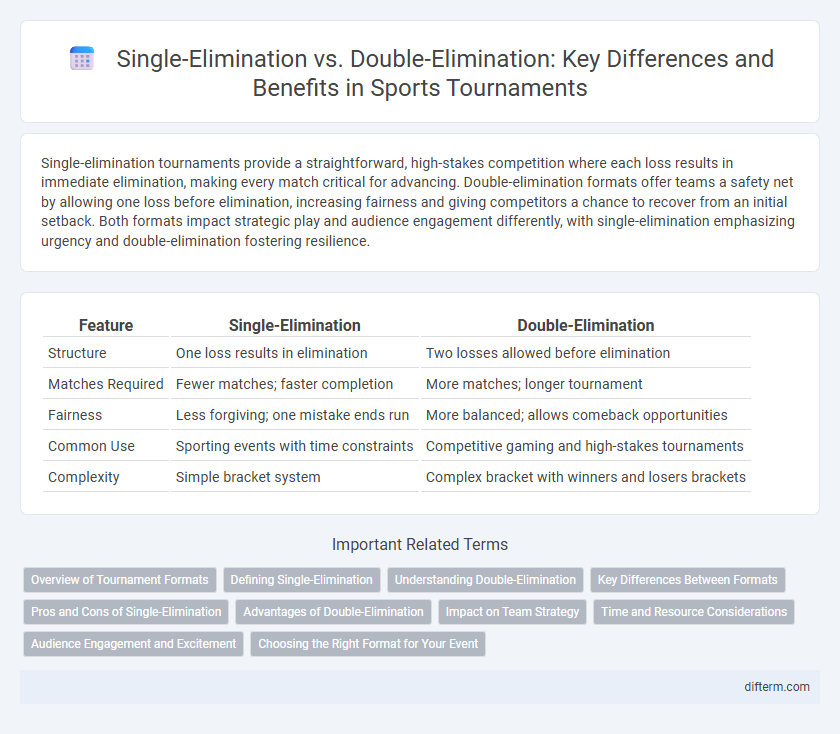Single-elimination tournaments provide a straightforward, high-stakes competition where each loss results in immediate elimination, making every match critical for advancing. Double-elimination formats offer teams a safety net by allowing one loss before elimination, increasing fairness and giving competitors a chance to recover from an initial setback. Both formats impact strategic play and audience engagement differently, with single-elimination emphasizing urgency and double-elimination fostering resilience.
Table of Comparison
| Feature | Single-Elimination | Double-Elimination |
|---|---|---|
| Structure | One loss results in elimination | Two losses allowed before elimination |
| Matches Required | Fewer matches; faster completion | More matches; longer tournament |
| Fairness | Less forgiving; one mistake ends run | More balanced; allows comeback opportunities |
| Common Use | Sporting events with time constraints | Competitive gaming and high-stakes tournaments |
| Complexity | Simple bracket system | Complex bracket with winners and losers brackets |
Overview of Tournament Formats
Single-elimination tournaments feature teams or players competing in one-off matches where a single loss results in elimination, making the format swift and high-stakes. Double-elimination tournaments allow participants to remain in the competition after one loss by moving to a losers' bracket, providing a chance for redemption and ensuring more matches. These formats impact tournament length, competitor fatigue, and spectator engagement differently, with single-elimination favoring concise schedules and double-elimination offering a more comprehensive competition structure.
Defining Single-Elimination
Single-elimination tournaments eliminate teams after a single loss, making each match a high-stakes contest where only the winner advances. This format is widely used in major sports events like the NCAA Basketball Tournament and the FIFA World Cup knockout stages due to its simplicity and time efficiency. Single-elimination emphasizes immediate performance, creating intense competition but offering no opportunity for teams to recover from an early defeat.
Understanding Double-Elimination
Double-elimination tournaments allow participants to remain in contention after their first loss, providing a second chance through the losers' bracket, which increases fairness and competition intensity. This format results in more matches than single-elimination, giving a clearer ranking by allowing teams to recover from an early defeat and still potentially win the championship. Understanding double-elimination requires recognizing its balance between competitiveness and fairness, making it popular in sports like esports, baseball, and wrestling.
Key Differences Between Formats
Single-elimination tournaments eliminate teams after a single loss, creating a straightforward progression to the championship that maximizes suspense but offers no second chances. Double-elimination formats allow teams to lose once and remain in contention, increasing fairness by providing a redemption opportunity and typically resulting in more games played. The choice between formats impacts scheduling, competitive balance, and viewer engagement, with single-elimination favoring brevity and unpredictability, while double-elimination prioritizes resilience and comprehensive competition.
Pros and Cons of Single-Elimination
Single-elimination tournaments offer the advantage of faster completion and simpler scheduling, making them ideal for events with limited time or resources. However, this format increases the risk of early elimination for strong competitors due to a single poor performance, reducing opportunities for redemption. The straightforward structure enhances spectator excitement but may not always determine the most consistent or deserving champion.
Advantages of Double-Elimination
Double-elimination tournaments offer participants a second chance after an initial loss, reducing the likelihood of early elimination due to a single bad match. This format increases fairness by allowing teams or players to recover and still compete for the championship. Fans benefit from more matches and intense competition, enhancing overall viewer engagement and tournament excitement.
Impact on Team Strategy
Single-elimination tournaments demand peak performance in every match, as a single loss results in elimination, prompting teams to adopt highly aggressive or conservative strategies based on immediate survival. Double-elimination formats allow teams a margin for error with a secondary bracket, encouraging risk management and long-term planning across multiple games. This structure influences coaching decisions on player rotation, resource allocation, and tactical adaptability to balance immediate outcomes with overall tournament endurance.
Time and Resource Considerations
Single-elimination tournaments require fewer matches, significantly reducing the total time and resources needed for completion, making them ideal for events with tight schedules or limited venues. Double-elimination formats demand more matches to accommodate the losers' bracket, increasing the duration and logistical costs but providing teams a second chance and often leading to a fairer outcome. Organizers must balance the efficiency of single-elimination with the competitive fairness and increased audience engagement that double-elimination offers.
Audience Engagement and Excitement
Single-elimination tournaments generate high audience engagement by creating intense, win-or-go-home scenarios that heighten excitement every match. Double-elimination formats maintain suspense by giving teams a second chance, keeping fan interest alive for longer periods and building narrative tension. The continuous opportunity for redemption in double-elimination often results in sustained crowd enthusiasm and dynamic storytelling throughout the event.
Choosing the Right Format for Your Event
Choosing the right format for your sports event depends on factors like the number of participants, time constraints, and desired competitiveness. Single-elimination tournaments offer a fast-paced structure where each loss eliminates a team, making them ideal for events with limited time. Double-elimination formats provide teams a second chance after one loss, increasing fairness and engagement but requiring more matches and scheduling flexibility.
Single-elimination vs Double-elimination Infographic

 difterm.com
difterm.com